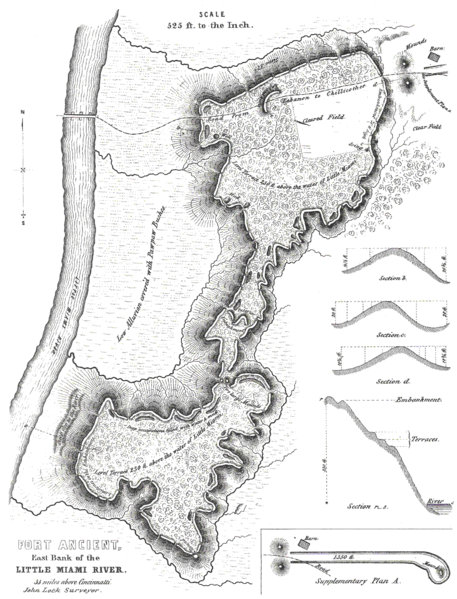古堡
地点:黎巴嫩、俄亥俄州
描述:根据维基百科:
“古堡是美洲原住民土方工程的集合,位于俄亥俄州沃伦县华盛顿镇,沿着小迈阿密河东岸,距黎巴嫩东南约 7 英里(11 公里),位于 350 号国道旁。该遗址是最大的史前遗址美国山顶围场,占地 100 英亩(0.40 平方公里),建筑群内有三又半英里(18,000 英尺)的围墙。 该遗址由公元前 1 世纪至公元 6 世纪居住在该地区的霍普韦尔 (Hopewell) 人建造,位于小迈阿密上方 270 英尺 (82 m) 处树木繁茂的悬崖上。”
“古堡的土方工程分三个阶段建造,历时约 400 年。 鹿的肩胛骨、劈开的麋鹿角、蛤壳锄头和挖掘棒被用来松动泥土,并用可容纳 35 至 40 磅的篮子来搬运和分发泥土。 考古学家估计城墙内的泥土总体积为 553,000 立方码(423,000 立方米) 3).”
“约翰·洛克 (John Lock) 于 1843 年访问并勘察了该遗址。在埃德温·汉密尔顿·戴维斯 (Edwin Hamilton Davis) 和以法莲·乔治·斯奎尔 (Ephraim George Squier) 所著的《密西西比河谷古代纪念碑》中,他们将古堡描述为“即使不是最广泛的工作,也是最广泛的工作之一……”就其规模而言,“整个西方”。 [47]
密西西比河谷的古代纪念碑记载如下:
“在山的陡坡上,在最接近河流的地方,可以清楚地追踪到三个平行的阶地,这些阶地在原始地图中没有显示,但在这里标出了。 它们并非不可能是自然形成的,并且是由连续的土体滑动形成的,这一特征在西方并不罕见。 然而,从其巨大的规律性来看,它们似乎是人造的,并且被大多数人如此看待。 从他们那里可以清楚地看到山谷两个方向的美景。 不过,或许,这并不比从堤坝延伸的山顶上获得的结果更好。 有人认为它们被设计成车站,以骚扰沿河乘船或独木舟经过的敌人。”
“堤坝上有七十多个入口或中断处,沿线间隔不规则。 由于迄今为止给出的原因,很难相信它们都被设计为入口或出口的地方。 我们只能根据这样的假设来解释它们的数量:它们曾经是由木材制成的碉堡或堡垒,并且早已腐烂。 这些开口最初大约有十到十五英尺宽。”
“可以看出,这部作品由两个大部分组成,两个部分之间的通道又长又窄。 脖子上挂着一堵普通尺寸的墙,仿佛是为了在任何一个主要师被携带的情况下阻止敌人进一步前进——这一特征虽然可以确定该部队的军事起源,工作的同时,也体现了建设者的技术和远见。 这种远见进一步体现在对修建城墙所需的挖掘工作进行管理,以形成许多大型水库; 与源自工程内的泉水相结合,足以为任何可能在入侵者面前进行最后抵抗的居民提供水源。 即使没有这些来源,而且工作四面八方,面对最庞大的投资,也很容易获得充足的供应。”
“回顾这座宏伟的纪念碑,我们一定会对所选择的技术以及确保这一地位的行业感到钦佩。 在军事制度下,正如我们认为建造这项工程的人所保证的那样,它一定是坚不可摧的。 从各个角度来看,它无疑是这片大陆上最有趣的古代遗迹之一。” [48]
摩尔门经指出:
阿尔玛书 21:149-150 – “149 事情是这样的,十九年十一月十日,拉曼人的军队逼近艾蒙尼哈地。 150看啊,城市已经重建,摩罗乃已在城市边界驻扎了一支军队,他们在周围堆起泥土,以保护他们免受拉曼人的箭和石头的伤害:因为看啊,他们战斗用石头和箭。”
阿尔玛书 22:1-3 – “1 事情是这样的,摩罗乃没有停止为战争做准备,也没有停止防御拉曼人; 因为他命令他的军队在士师统治第二十年开始,开始在尼腓人占领的所有土地周围的所有城市周围挖土堆。 2他在这些土脊的顶部建造了木材; 是的,在城市周围建造了人高的木结构建筑。 3他规定在这些木料上,周围应有一个木桩框架; 他们又强又高; 他还下令修建了塔楼,俯瞰着那些纠察队。”
阿尔玛书 24:54-55 – “54 提安库姆按照摩罗乃的命令,让他们开始在邦蒂富尔城周围挖一条沟渠; 55他命令他们在沟渠的内岸用木料建造护墙; 他们把沟里的泥土倒在木料的胸墙上。”
